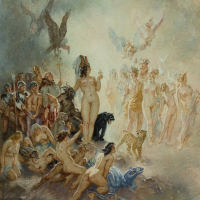21. NORMAN LINDSAY

Visitors to Maitland in the Hunter Valley will see stretched across the prominent faade of the public library huge images taken from Norman Lindsays iconic childrens book The Magic Pudding. Without text or commentary, the images are a reminder, if one was needed, of the enduring place of Lindsays work in the imagination of generations of children, as loved and recognisable today as they were a century ago.
To most Australians with a passing interest in art, Norman Lindsay epitomised what it was to be an artist immensely talented and creative, controversial, instantly recognisable, loved and derided in equal measure. His works have been collectable for more than a century, even today spanning the divide between popular culture and the world of high art. While his place among critics and academics might be questionable, in the wider world his appeal remains. Current generations may find his subjects, and especially his depictions of women, humorous and patronising rather than shocking, his capacity to cause outrage and controversy lingers, long after the culture wars that spawned them have been largely forgotten.
Norman Lindsay, with his siblings Percy (1870-1952), Lionel (1874-1961), Ruby (1885-1919) and Daryl (1889-1976), produced a huge body of work in every medium. Lionel was a printmaker par excellence, while the oldest brother Percy was a lyrical and popular painter. The youngest, Daryl, would become a stalwart of the art establishment and Director of the National Gallery of Victoria. Sister Ruby, a fine painter and illustrator, married friend and fellow artist Will Dyson (1880-1938), creating a family dynasty of formidable achievement. Norman worked in all media, but it was as an illustrator for the popular press that he first found notice. By the outbreak of war in 1914 he had become the most highly paid artist in the country, backing his personal art production with cartoons and illustrations for The Bulletin, the most significant news publication in Australia. His visual art was matched by his widely published writing, especially his light and satirical novels that equalled his artwork in their capacity to cause shock and outrage. Lindsays penchant for affront stemmed from his readings of the philosophy of Friedrich Nietzsche, especially his Antichrist, published in 1895. Nietzsches views on the evils of Christianity and the need to return to the old gods and beliefs would be controversial enough, but Norman Lindsays capacity to graphically visualise such ideas soon thrust him forward as a figure of controversy and debate in the archly conservative Australia of the early twentieth century. Time and again Lindsay returned to the themes of good and evil, of libertarian beliefs versus wowserism, the blind and puritanical condemnation of anything to do with sexual expression, and his imaginings of heaven and hell. In Lindsays view of the upper and lower worlds, it was not the lustful pleasure seekers who were condemned to hell, but the hypocrites and corrupt priests, the overweening politicians, grasping businessmen and warmongers who slithered around with the lizards, toads and ancient hags of the nether regions.
The Passing of the Gods is a late work in Lindsays career, but shows his continued obsession with the battles between good and evil, played out by his pantheon of gods and cast list of the condemned. In a manner he made his own, the gods are bathed in dazzling light as they make their procession towards an ideal world. Pan and Bacchus strut along with their nubile companions, while casting a leery eye at the denizens of the dark side who look back with equal disdain. The tangled group, focussed on a statuesque nude in elaborate headdress, is made up of a motley collection of priests and bishops, of soldiers, snakes and slimy underworld creatures writhing around in an erotic melange. Both groups feature naked women, on one side the lithe and pretty handmaidens of the gods, on the other a tangle of abandoned flesh. Evil is the black panther, good the richly spotted leopard. Over the decades Lindsay has lost none of his passion, his facility or imagination in a painting that epitomises his work over a lifetime.
Gavin Fry BA[Hons], MA, M.Phil